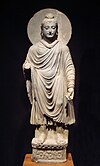
Back الدولة الغزنوية Arabic الدوله الغزنويه ARZ Imperiu gaznávida AST Qəznəvilər dövləti AZ Ғәзнәүиҙәр дәүләте BA Imperi dels Gaznèvides Catalan Imperyong Gasnabida CEB دەوڵەتی غەزنەوی CKB Ghaznovská říše Czech Ghaznavideriget Danish
Ghaznavid Empire Gaznevîyyûn غزنويون غزنویان | |||||||||||||
|---|---|---|---|---|---|---|---|---|---|---|---|---|---|
| 963–1186 | |||||||||||||
|
Flag | |||||||||||||
| Capital | Ghazni | ||||||||||||
| Common languages |
| ||||||||||||
| Religion | Sunni Islam | ||||||||||||
| Government | Monarchy | ||||||||||||
| Sultan | |||||||||||||
| History | |||||||||||||
• Established | 963 | ||||||||||||
• Disestablished | 1186 | ||||||||||||
| |||||||||||||
The Ghaznavid Empire was a Khorāṣānian Karluk 'persianate' Sunni Muslim state, which existed from 975 to 1187. It was centred in Ghazni, a city in the present Afghanistan. It ruled much of Persia, Transoxania, Pakistan and the northern parts of India. The Ghaznavids are known for laying the foundation of Islamic rule in northern India when they conquered Peshawar and the entire Punjab region including Haryana up to Delhi in the year 1001. Their last outpost of conquest in north India was in Meerut city in Uttar Pradesh. The Ghaznavids relied strongly on Persian language and Persian culture and are therefore classified heavily as a "Persianate" empire.

